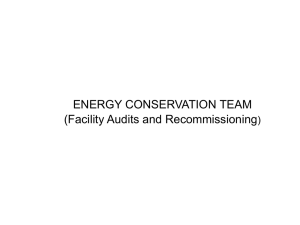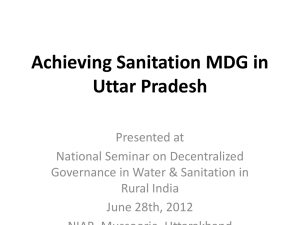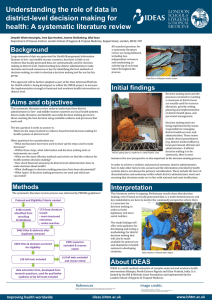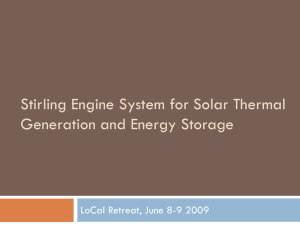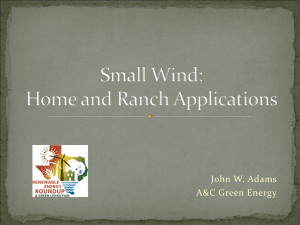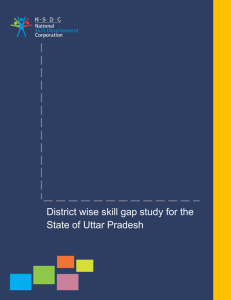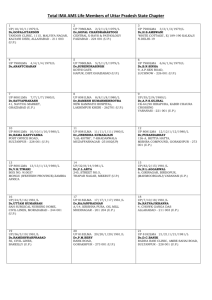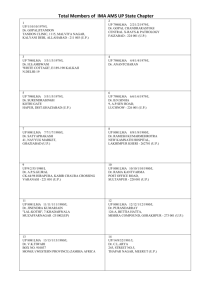Perform, Achieve & Trade (PAT) Mechanism
advertisement
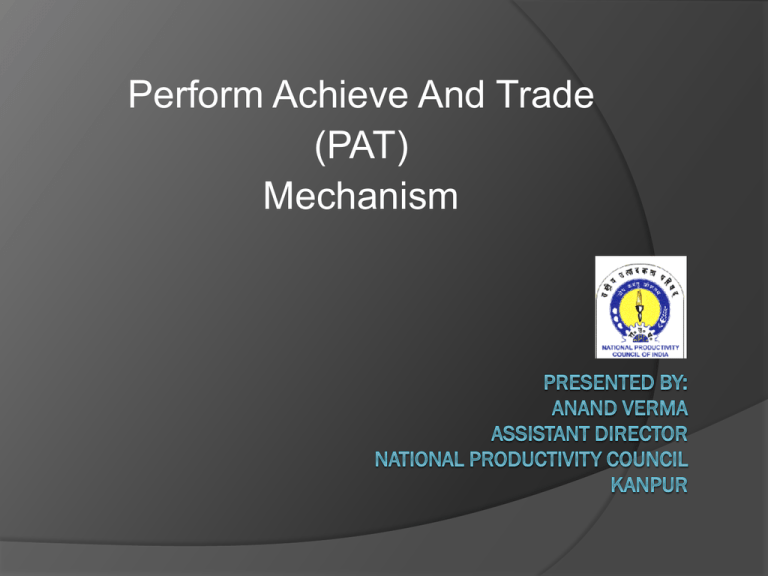
Perform Achieve And Trade (PAT) Mechanism Target Setting Methodology for Power Sector under Perform, Achieve & Trade (PAT) Mechanism Bureau of Energy Efficiency (BEE) Power Plants traditionally focus on Improvement (Reduction) Consumption of Gross Heat Rate Reduction in Auxiliary Power Target Setting of Power Plants for PAT Mechanism would mainly depend upon Net Heat Rate (NHR) to include both i.e. GHR & APC Net Heat Rate = Gross Heat Rate / (1- APC%) Parameter Plant-1 Plant-2 Gross HR(GHR) 2500 Kcal/Kwh 2500 Kcal/Kwh APC 8% 10% Net HR (NHR) 2717(= 2500/0.92) Kcal/Kwh 2777(=2500/0.90) KCal/Kwh Parameter to be Considered for Target Setting Annual Generation (MUs) & PLF(%) Design Gross Station Heat Rate (Kcal/Kwh) Annual Operating Gross Station Heat Rate (Kcal/Kwh) Annual Operating Auxiliary Power Consumption (%) Quality of Coal i.e. Average GCV (Kcal/Kg) & Ash Content(%) Or Average GCV of Gas used Annual Quantity of Coal Consumed in Tonnes (M³ of Gas in case of Gas Plants) Annual Quantity of Secondary Oil Consumed in Tonnes Target Setting for Reduction of NHR Variation in Net Station Heat Rate from Design Net Heat Rate % Reduction Target for Deviation in Net Station Heat Rate (%) % Reduction in Net Station Heat Rate Up to 5 % 15 % 0.75 More than 5% and Up to 10 % 20 % 1.0 – 2.0 More than 10% and Up to 20% 27 % 2.70 – 5.4 More Than 20 % 34% 6.8 and above Example - 1 Installed Capacity = 420MW Station Design Heat Rate = 2450 Kcal/Kwh Annual PLF = 55.72 % Annual Average Operating Station Heat Rate = 2650 Kcal/Kwh Average APC = 9.7 % Annual Production in MUs = 2050.28 Net Operative Heat Rate = 2936.29 Net Design Heat Rate = 2714.68 % Deviation = 8.16 Target % Reduction = 20% of 8.16 = 1.632 % of Operating NHR Target NHR Reduction : 47.94 Kcal/KWh Reduction Target in TOE = 9829 Example - 2 Installed Capacity = 1260MW Station Design Heat Rate = 2301.6 Kcal/Kwh Annual PLF = 90.03 % Annual Average Operating Station Heat Rate = 2347.67 Kcal/Kwh Average APC = 8.69% Annual Production in MUs = 9937.7 Net Operative Heat Rate = 2571.00 Net Design Heat Rate = 2520.55 % Deviation = 2 % Target % Reduction = .3 % of Operating NHR Target NHR Reduction = 7.72Kcal/Kwh Reduction Target in TOE = 7670.7 DCs to be covered by NPC S.No. State Sector Name Of Plant 1 Uttar Pradesh Power Plant Auraiya Gas Power Station 2 Uttar Pradesh Power Plant Feroze Gandhi Unchahar Thermal Power Project 3 Uttar Pradesh Power Plant Harduaganj Thermal Power Station 4 Uttar Pradesh Power Plant Parichha Thermal Power Project 5 Uttar Pradesh Power Plant Anapara Thermal Power Station 6 Uttar Pradesh Power Plant National Capital Power Station, Dadri 7 Uttar Pradesh Power Plant Obra Thermal Power Station 8 Uttar Pradesh Power Plant Panki Thermal Power Station 9 Uttar Pradesh Power Plant Rihand Super Thermal Power Project 10 Uttar Pradesh Power Plant Singrauli Super Thermal Power Station 11 Uttar Pradesh Power Plant Tanda Thermal Power Station BASELINE ENERGY AUDIT SCOPE OF WORK METHODOLOGY ADOPTED KEY ENABLERS FOR THE STUDY Baseline Audit Scope of Work Review of the energy consumption and production data of last 5 years as per the data reported by the industry to BEE. A copy of the reported data will be provided by BEE to the agencies / firms. Our Approach Review of energy data for 5 years will be done vis-à-vis MIS, annual reports, reports submitted to MoP, ORT (CEA) reports etc. Baseline Audit Scope of Work Study the process of the entire plant considering a gate-to-gate concept which would mention type & quantity of energy sources consumed, self generated energy sources, process technology, raw material, product output and various variable factors which affect the energy consumption significantly. Our Approach Based on considerable experiences in Thermal Power Sector, our team would study the entire plant on a gateto-gate concept, based on flow diagrams such as Coal Handling Plant (CHP), milling system, boiler systems, turbine system, condenser system, draft system, regenerative feed heating system, AHP, cooling towers, HT auxiliaries like BFPs, FD & ID fans, Mills etc. LT auxiliaries like air compressors, HVAC, lighting, conveyors etc. Baseline Audit Scope of Work Identify major energy intensive processes, equipments etc inside the plant boundary where more than 80% of total energy consumption of the plant are accounted. Efficiency evaluation and assessment of energy performance of above major equipment. Compare the performance data with design data or PG report. Our Approach Main auxiliaries accounting for more than 80% of APC will be established. Energy performance of main equipment will be assessed w.r.t. to technical specifications/ PG test values based on operational data, recent records, onsite data etc. As run performance will be compared with PG test data/technical specifications/last post overhaul data in case of very old plants Baseline Audit Scope of Work Observe and compile various Energy Conservation (ENCON) options implemented by the plant for the last 3 years. Evaluate the saving potential available in the plant which would occur due to process change, efficiency improvement, retrofitting or fine tuning of operational parameters. Our Approach Plant inputs on ENCON options implemented will be collected from plant people based on MIS reports, annual reports, BEE National Energy Conservation awards, data etc as relevant. Energy savings potential will be brought out w.r.t. various subsystems from margins w.r.t. PG values or best practice norm values, vendor information. Baseline Audit Scope of Work Preparation of audit report containing the summary of savings, investment required etc. the report should also be discussed and accepted by the competent authority of the industry. Our Approach The summarized ENCON options / Cost Benefits will be discussed with management competent authority. Our Approach (Cont.) Team composition is being finalized based on project locations. The team consists of: One Certified Energy Auditor Two Energy Engineers Two Project Associates About 10 days of baseline audit is envisaged. Team compositions are being firmed up given prior commitments / logistics modalities. Our Approach (Cont.) There will be an opening meeting on Day 1 to discuss the plans, mutual intros , team organization and facilitation needed. There will be a closing meeting on last day to present the draft findings of team and soliciting feedback on meetings Key Enablers Technical diary of the plant (Design data) PG test data/OEM specifications of various equipment Three annual reports, ORT reports, MIS reports etc. Free access to UCB data, onsite data, Lab data (Coal/ ash analysis, water quality, %O2 values etc.) Access to past energy audit reports of the plant Full time association of Energy Manager of the plant and suitable O&M functionary. Key Enablers (Cont.) Decent Stay and local transport arrangements for NPC team, at GOI rates since it is a MoP project, moreover, NPC too is an institution under DIPP, Ministry of Commerce and Industry, Government of India. All information will be kept confidential. The study will commence only after approval of DCs on a mutually agreeable dates
